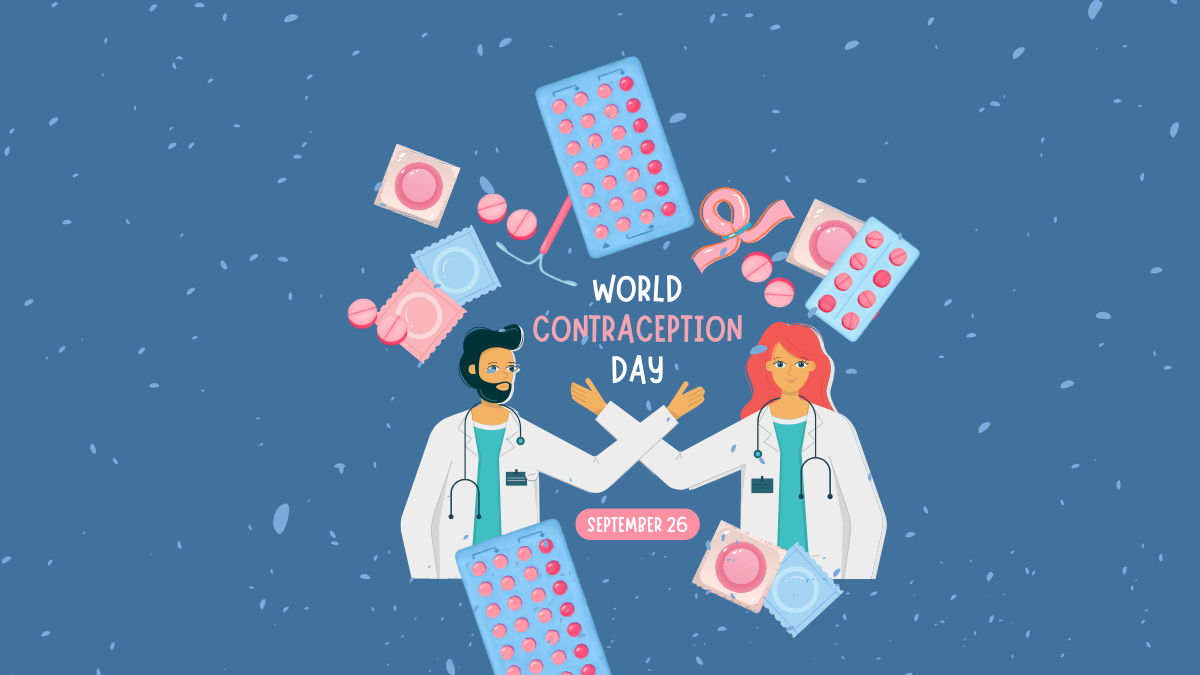World Contraception Day, observed annually on September 26, stands as a beacon of awareness in the realm of reproductive health. This global campaign is dedicated to raising consciousness about contraception and promoting informed decision-making in sexual and reproductive health matters. By equipping individuals with knowledge and access to various contraceptive options, the day aims to reduce unintended pregnancies and enhance accessibility to vital reproductive health services worldwide.
Understanding Contraception: A Key to Reproductive Health
Defining Contraception
Contraception encompasses the range of methods or devices employed to prevent pregnancy by interfering with the natural processes of ovulation, fertilization, or implantation. These methods play a pivotal role in family planning and overall reproductive health.
The Importance of Contraception
The significance of contraception extends far beyond mere pregnancy prevention:
- It allows individuals and couples to make informed decisions about when or if they want to have children.
- It contributes to reducing unintended pregnancies, which can have profound social and economic implications.
- It plays a crucial role in improving maternal and child health outcomes.
- It empowers people, especially women, by providing control over their reproductive choices.
- When barrier methods like condoms are used, it aids in reducing the spread of sexually transmitted infections (STIs).
Theme of World Contraception Day 2024
“A choice for all. Freedom to plan, power to choose.”
The theme for World Contraception Day 2024 encapsulates the essence of reproductive rights and empowerment. It emphasizes several key principles:
- Universal Access: Every individual, regardless of their background, should have access to contraceptive options.
- Informed Decision-Making: People should have the freedom to make choices about their reproductive health based on accurate information.
- Removing Barriers: Whether financial, societal, or educational, barriers to contraception access should be eliminated.
- Empowerment: The theme underscores the power that comes with having control over one’s reproductive choices.
The History of World Contraception Day
Origins and Development
World Contraception Day was established in 2007 as part of a comprehensive international initiative. Its primary goals were to:
- Spread awareness about contraception methods and their importance.
- Reduce the global incidence of unintended pregnancies.
- Address challenges related to family planning and contraception access, particularly in regions with limited healthcare infrastructure.
Support and Collaboration
The day garnered support from prominent global organizations, including:
- The United Nations Population Fund (UNFPA)
- The World Health Organization (WHO)
- Various non-governmental organizations dedicated to reproductive health
Addressing a Global Need
The campaign emerged in response to a pressing global issue: despite the widespread availability of contraceptive methods, millions of people still face significant barriers in accessing reliable family planning options. These barriers include:
- Cultural stigmas surrounding contraception use
- Lack of comprehensive sexual education
- Insufficient healthcare resources, particularly in developing countries
World Contraception Day aims to confront these challenges head-on by advocating for universal, stigma-free access to contraception.
The Significance of World Contraception Day
Empowering Informed Decisions
At its core, World Contraception Day is about empowerment through education. It seeks to bridge the knowledge gap that many adolescents and adults face when it comes to family planning. By encouraging open discussions and educational initiatives, the day fosters:
- Informed reproductive choices
- Greater personal autonomy in sexual health matters
- Reduced risks of unintended pregnancies and STIs
Reducing Unintended Pregnancies
Unplanned pregnancies can have far-reaching consequences:
- Social implications, such as disrupted education or career paths
- Economic challenges for individuals and families
- Increased health risks for both mother and child
By promoting family planning options and ensuring accessibility, World Contraception Day contributes to:
- Improved health outcomes for mothers and children
- Lower healthcare costs associated with unintended pregnancies
- Better overall quality of life for individuals and families
Challenging Stigma and Cultural Taboos
In many parts of the world, discussions about contraception remain taboo. World Contraception Day plays a pivotal role in:
- Breaking down cultural barriers surrounding reproductive health
- Normalizing conversations about contraception and sexual health
- Promoting the use of contraceptives as a responsible and normal choice
- Highlighting the need for male involvement in reproductive health discussions, fostering shared responsibility
Advancing Gender Equality
Access to contraception is a fundamental aspect of women’s empowerment. It:
- Gives women control over their reproductive health
- Allows women to make decisions about when and if they want to have children
- Supports greater gender equality by enabling women to pursue education, career opportunities, and personal goals
- Advocates for the removal of barriers that disproportionately affect women’s access to reproductive health services
Preventing Sexually Transmitted Infections
While contraception is primarily associated with pregnancy prevention, it also plays a vital role in sexual health:
- Barrier methods, like condoms, protect against STIs
- Promoting contraception use contributes to better overall sexual health awareness
- Encourages regular health check-ups and screenings as part of reproductive health care




 World Basketball Day 2025 Celebrates Bas...
World Basketball Day 2025 Celebrates Bas...
 UN Celebrates Second World Meditation Da...
UN Celebrates Second World Meditation Da...
 Winter Solstice 2025 Observed on Sunday,...
Winter Solstice 2025 Observed on Sunday,...







